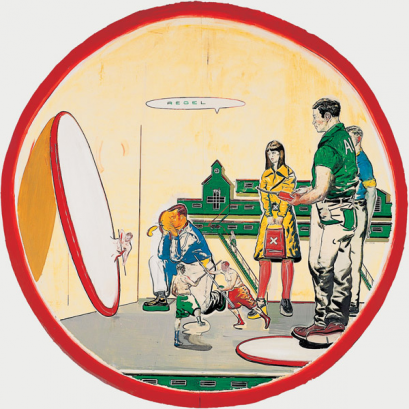|
Who bought their works during the golden age of such artists now cannot find anyone interested in buying these works from them. Auctioneers show no interest at all; the former galleries no longer exist, have parted with the artists or refuse to buy “early works” of their artists back. So what’s left? Internet auctions? There is no room for really expensive art there, even if a piece of art is worth “only” 10,000 euros. Newspaper advertisements? Forlorn hope; who wants to spend money on art whose creators can hardly be remembered these days? Perhaps the great-grandchildren will be in a position to sell the pictures as antiques in a hundred years time; but even they will have difficulties – for who will accept a pile of neon lamps as valuable pieces of art then? Thus, all this talk about success and profits on the art market turns out to be a talk about a few isolated success stories. The art market is about gambling. You simply buy as much as possible for as little as possible and hope that one of these artworks will become so valuable that it counterbalances all was worth investing in such works for the risks were calculable and the chances for massive increases in value were considerable. Over time, however, the interest waned, as people began to invest in even newer, younger artists. Two well-known examples in Germany and, at the same time, two of the few artists who admit their failure on the market are Gerhard Merz und Ullrich Meister. The latter became famous as a result of his participation in the 1992 documenta and numerous exhibitions in important museums thereafter; the former presented a glistening light installation in the German pavilion at the 1997 Biennale in Venice. In other words, The media are full of ever more sensational news about auction records. Everywhere new galleries are being established. There are a multitude of art fairs. Advisors and agencies are offering their assistance to new collectors. No doubt, the art market is booming. Yet is art really such a crisis-proof opportunity for investment as we are all being promised, or is art one of the biggest moneydestruction machines of the last decades? Certainly, on the one hand, we have got the success stories of people like Neo Rauch or Matthias Weischer whose works increased in value several hundred percent in only a few years; dimensions of profit that a r e s e e n a s u t o p i a n in other sectors of the economy and that could never be reached by legal means there. Yet is it possible that every picture automatically gains in value? Is the art market not at heart a one-sided game played by a small number of traders? The thing is that when you have a closer look at the art market, you will find more losers than winners. And more people have invested money that they will never get back than there are winners of the art market. There is, however, a conspicuous silence on the matter because nobody, of course, wants to seem like they bet on the wrong horse and collected the wrong artists. As always, it is only the success stories that are written about – for at the end of the day, it is not only the traders making a living on this, but also the artist and by extension the critics. If you try, however, to sell one of the pieces of art that you bought ten years ago in some young artist’s gallery, you are f o r c e d t o a c c e p t t h a t there is not the slightest demand for these pieces. It is as if you were offering rotten potatoes. We are not even talking about artists here who have put up only a few exhibitions in third-rate galleries and then went on to do completely different things, but about artists who have displayed, and continue to display, their works in well-known exhibitions and whose pieces do not just end up in the repositories of museums but can actually be seen at exhibitions. At the same time, these artists haven’t quite managed to become international superstars. Many collectors enjoyed buying these artists for a while because their artworks made collections look young and dynamic. They were considered to be future superstars. It these are rather well-known artists whose works are generally accepted and have a recognition value. Yet their works proved to be too bulky to generate a real demand. The collectors the losses. On the shares and bond markets, as a rule, even in real estate, financial investments are less risky. This means that there is only one option for collectors: to hope that one day these artists will be rediscovered; otherwise they can only store the pictures in the attic or, if they still happen to like them, let them hang on the walls of the living-room. The knowledge remains that 20,000 theoretical euros are hanging there that, apart from the tax office, nobody cares about. Well, yes, with that money you could have done other nice things; but that is a profane thought which is not to be expressed in artistic circles. As for a conclusion and lessons for the future: only invest in secure assets! Most major collectors of art are already doing this, and it is furthering the well-known monotony on the art market and in large collections. With big names at least you know that one way or another you’ll be able to get rid of the stuff again. Or you completely ignore all this tattle about money and the hype about markets, and you simply buy what you like. From the perspective of art, that is perhaps the best option.


Рекомендуемые статьи

|
|
Goff & Rosenthal gallery, Berlin, November 18 - December 30, 2006
Society permanently renegotiates the definition of drugs and our relationship towards them. In his forty-five minute found-footage film The Conquest of Happiness, produced in 2005, Oliver Pietsch, a Berlin-based video artist, demonstrates which drugs society can accommodate, which it cannot, and how the story of the drugs can be…
|

|
|
Borrowing heavily from fairy tales, fables and science fiction, the art of Magda Tóthová revolves around modern utopias and social models and their failures. Her works address personal and social issues, both the private and the political. The stylistic device of personification is central to the social criticism emblematic of her work and to the negotiation of concepts used to construct norms.…
|

|
|
We’re constantly hearing that someone would like to do some joint project, organize something together, some event, but… damn, how to put it... we really like what you’re doing but it might piss someone off back home. Sure, it’s true that every now and then someone gets kicked out of this institution or that institute for organizing something with Divus, but weren’t they actually terribly self…
|

|
|
Why political intellectuals, do you incline towards the proletariat? In commiseration for what? I realize that a proletarian would hate you, you have no hatred because you are bourgeois, privileged, smooth-skinned types, but also because you dare not say that the only important thing there is to say, that one can enjoy swallowing the shit of capital, its materials, its metal bars, its polystyrene…
|
|








Комментарии
Статья не была прокомментированаДобавить новый комментарий